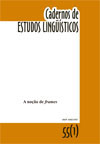Resumen
Este artigo tem como foco a reflexão sobre a linguagem metafórica em uso. A abordagem defendida busca articular os planos de sentido "e" (estável) e "e’" (episódico/emergente) para compreender a construção metafórica no discurso. Entre os aspectos constituintes de ambos os planos, os frames (online e off-line) se mostram como conceitos centrais na produção de sentidos figurados na linguagem em uso.Citas
BLACK, M. Metaphor (1962). In: BLACK, M. (Org.) Models and Metaphor. New York: Cornell University Press.
BRONZATO, L, H. (2012). O segredo do sucesso que a gramática e a metáfora não escondem. In: VEREZA, S, C. Sob a Ótica da Metáfora: tempo, conhecimento e guerra. Niterói: EDUFF, p. 179 - 196.
CAMERON, L. (1999). Identifying and describing metaphor in spoken discourse data. In: CAMERON, L. e G. LOW (Orgs.) Researching and Applying Metaphor. Cambridge: Cambridge University Press.
CAMERON, L. Metaphor shifting in the dynamics of talk. (2008). In: ZANOTTO, M. S. et al. (Orgs.) Confronting Metaphor in Use: an applied linguistic approach. Amsterdam: J. Benjamins.
CAMERON, L. e DEIGNAN, A. (2006). The Emergence of Metaphor in Discourse. Applied Linguistics, n. 27(4), p. 671 - 690.
CAMERON, L. e MASLEN, R. (2010). (Orgs.) Metaphor Analysis: research practice in applied linguistics, social sciences and the humanities. London: Equinox.
COULSON, S. (2001). Semantic Leaps: frame shifting and conceptual blending in meaning construction. Cambridge: Cambridge University Press.
DEIGNAN A. (2005). Metaphor and Corpus Linguistics. Amsterdam: John Benjamins.
FAUCONNIER, G. (1985). Mental Spaces: Aspects of meaning construction in natural language. Cambridge: The MIT Press.F AUCONNIER, G. e TURNER, M. (1998). Conceptual Integration Networks. Cognitive Science, n. 22: 2, p. 133 - 187.
FILLMORE, C. Frame Semantics. (2006). In: GEERAERTS, G. Cognitive Linguistics: basic readings. Berlim: Mouton de Gruyter, p. 373 - 400.
FORCEVILLE, C. J. e URIOS-APARISI, E. (2009). (Orgs.) Multimodal metaphor. Berlim: Mouton de Gruyter. GEERAERTS, D. (2006). Cognitive Linguistics: basic readings. Berlim: Mouton de Gruyter.
VEREZA – entrelaçando frames: a construção... GIBBS, R. (1984). Literal Meaning and psychological theory. Cognitive Science, n. 8, p. 275 - 304.
VEREZA; BOGDONOVICH, J., SYKES, J., e BARR, D. (1997). Metaphor in idiom comprehension. Journal of Memory and Language, n. 37, p.14 - 154.
VEREZA; e BOGDONOVICH, J. (1999). Mental imagery in interpreting poetic metaphor. Metaphor and Symbol, n.14, p. 37 - 44.
GOLDBERG, A. (2006). Construction Grammar In: GEERAERTS, G. Cognitive Linguistics: basic readings. Berlim: Mouton de Gruyter, p. 401 - 438.
HALLIDAY, M. A. e MATTHIESSEN, C. M. (2004). An Introduction to Functional Grammar. Oxford: OUP.
HOUGAARD, A. E OAKLEY, T. (2008). Mental Spaces in Discourse and Interaction. Amsterdam: John Benjamins.
KÖVECSES, Z. (2005). Metaphor and Culture. Cambridge: Cambridge University Press.
LAKOFF, G. (1987). Women, Fire, and Dangerous Things. Chicago: University of Chicago Press.
LAKOFF, G. (1993). The contemporary theory of metaphor. In: ORTONY, A. Metaphor and Thought (2a ed.). Cambridge: Cambridge University Press, p. 202–251.
LAKOFF, G. (2004). Don’t Think of an Elephant!: know your values and frame the debate. Vermont: Chelsea Green Publishing.
LAKOFF, G. e JOHNSON, M. (2002). Metaphors We Live by. Chicago: University of Chicago Press. Tradução em português pelo grupo GEIM.
LAKOFF, G. e JOHNSON, M. Metáforas da Vida Cotidiana. Campinas, São Paulo, Mercado de Letras/EDUC. (original de 1980)
LAKOFF, G. e JOHNSON, M. (1999). Philosophy in the Flesh: the embodied mind and its challenge to western thought. Nova Iorque: Basic Books.
LAKOFF, G. e TURNER, M. (1989). More than Cool Reason: field guide to poetic metaphor. Chicago: University of Chicago Press.
RICHARDS, I. A. (1936). The Philosophy of Rhetoric. Oxford: Oxford University Press.
MIRANDA, N. S. (2009). Construções gramaticais e metáfora. Revista Gragoatá n. 26, p. 61 - 80.
SEMINO, E. (2008). Metaphor in Discourse. Cambridge: Cambridge University Press.
STEEN, G. (1994). Understanding Metaphor in Literature: an empirical approach. London: Longman.
VEREZA, S. C. (2006). Novos caminhos para o estudo da metáfora. In:
ZYNGIER, S., VIANA, V. e SPALLANZANI, A. Linguagens e Tecnologias: estudos empíricos. Rio de Janeiro: Publit, p. 145 - 164.
VEREZA, S. C. (2007). Metáfora e argumentação: uma abordagem cognitivo-discursiva. Linguagem em (Dis) curso, v. 7, n. 3, p 487 - 506.
VEREZA, S. C. (2010). O Lócus da Metáfora: linguagem, pensamento e discurso. Cadernos de Letras da UFF, n. 41, p. 199 - 212.
VEREZA, S. C. (2012). Sob a Ótica da Metáfora: tempo, conhecimento e guerra. Niterói: EDUFF.
ZANOTTO, M. S. et al. (2008). (Orgs.) Confronting Metaphor in Use: an applied linguistic approach. Amsterdam: J. Benjamins.
Se otorgan a la Revista CADERNOS DE ESTUDOS LINGÜÍSTICOS todos los derechos de autor relativos a los trabajos publicados. No se devolverán los originales. En virtud de su aparición en esta revista de acceso abierto, los artículos son de uso gratuito, con la debida atribución, en aplicaciones educativas y no comerciales.

